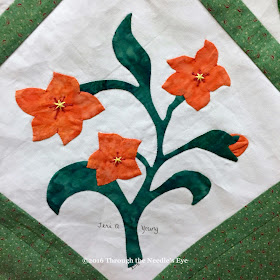Once upon a time, there were two friends who loved to stitch—so much so that we decided to join together and become a team, calling our business Through the Needle's Eye. We began designing and creating a fairy tale quilt, started teaching and lecturing, and began our blog.
In 2016, our fairy tale stitching included some fantastic experiences.
We designed several patterns in wool, having started with our ornaments last year. In fact, our first wool appliqué pattern, Marcia's Flowers, is available on our website, as well as at two local shops! Another pattern set is in the planning stages.
We taught a six-month crazy quilting class, including instruction on constructing the blocks, choosing and stitching motif designs, embellishing stitches with ribbon and beads, combination seam stitches, and finishing the project. We learned as much as our students in those creative classes!
We completed our Fairy Tale Album, which was accepted into a special exhibit at the International Quilt Festival in Houston in November, and it will also be included in the show in Chicago in the spring. It was such fun to see it there, especially seeing people study it to discover many of the stitched details.
A new granddaughter calls for a baby blanket, and what better design for a baby named Ella than to blow up the size of our Cinderella block pattern and work it in flannel? A few embroidered dimensional touches were her immediate favorite parts.
Among the many new projects in the works is a redwork quilt—using fairy tale motifs, of course! We were honored to be invited to teach at the Academy of Appliqué in Williamsburg in 2017 and have been busy preparing for that. So many ideas; so much stitching!
Tonight, we celebrate the end of a wonderful 2016 in great anticipation of the year to come, which promises many exciting opportunities, both in our stitching and our personal lives. We can't wait to see how it all unfolds.
So when the clock strikes midnight tonight, we won't worry that our carriage will become just a pumpkin. No, we will cling to our glass slippers and the sparkling promises they hold for the coming year—the next chapter in our happily ever after!
May you have a happy and prosperous 2017!



















































